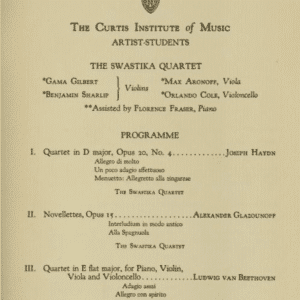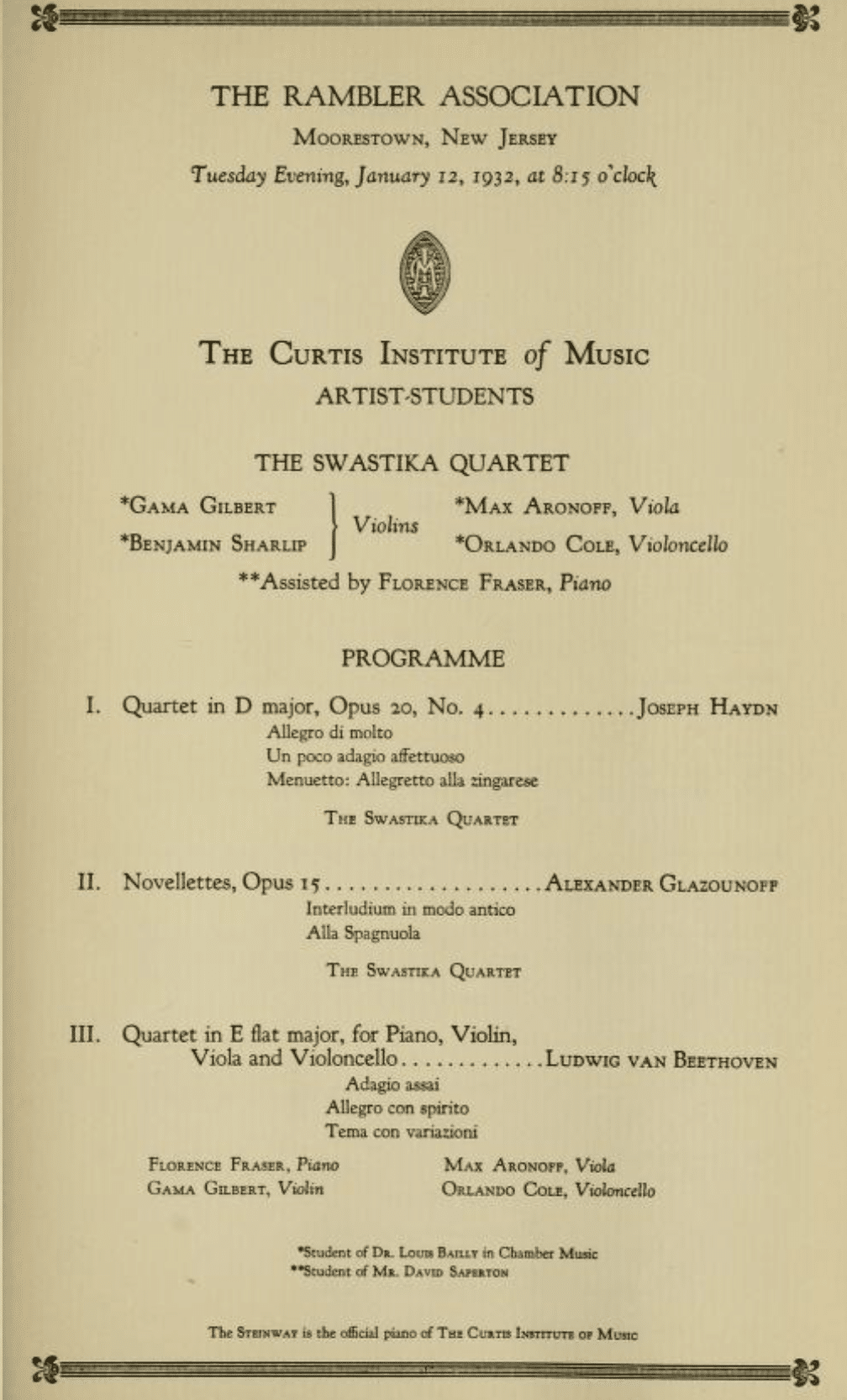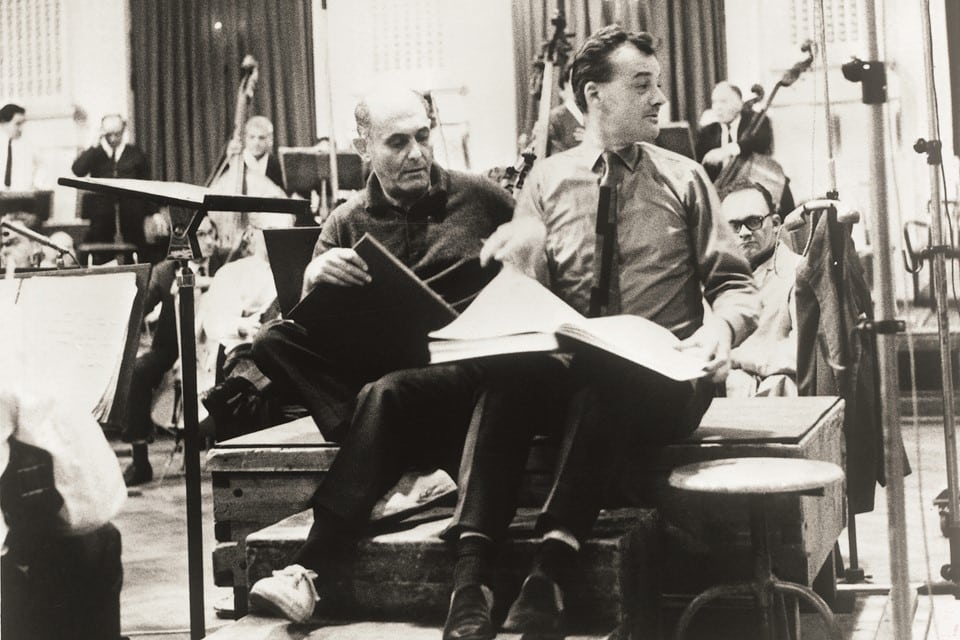Ever heard of the Swastika Quartet?
mainWhile researching his father’s early years, conductor Leonard Slatkin has reached the point where he was admitted to the Curtis Institute at age 15, the youngest at that time.
Looking at the school’s musical activities, Leonard came across programmes of the house quartet.

The group took its name from the home of Curtis founder Mary Louise Curtis Bok in Merion, Pennsylvania, called “Swastika”.
In 1933 it became the Curtis String Quartet.






which just further begs the question: why was she living in a house called the swastika?
Because, until the Nazis appropriated it, it was a quite harmless Indian fertility symbol.
why was she living in a house named for an Indian fertility symbol?
Because she wanted to.
Because she just did.
Like the nursery rhyme, “There was an old woman who lived in a shoe,” why did she live in a shoe?
Because if the old woman had lived in a Swastika, nothing would’ve rhymed with swastika.
There was an old woman who lived in a swastika.
She had so many children, she worked as a rag pickah”
Sorry.
Possibly a warmly cultivated recollection from a visit to the famous Kamasutra temples:
https://www.youtube.com/watch?v=88bvM2knJQw
[Because, until the Nazis appropriated it, it was a quite harmless Indian fertility symbol.]
The name is itself Sanskrit, from su asti, “it is well”, plus adjectival suffix ka, so “fortunate”, “good fortune”, and the like.
The swastika was a very popular good-luck symbol in the nineteenth and early part of the twentieth century. Look at: https://www.bbc.com/news/magazine-29644591 (How the world loved the swastika until the Hitler stole it.)
Mary Curtis, that admirable woman, and her husband Edward Bok will not even have been aware of Nazism when they named their house: the Nazi party only rose to prominence in 1930, the year Edward Bok died.
It is interesting that the name of the quartet was changed in 1933, when the danger of Nazism was beginning to be properly understood.
Mary Curtis mother, Louisa Knapp Curtis, was the first editor of the enormously popular Ladies’ Home Journal, and Mary wrote for it as a young teenager, and married the second editor, Edward W. Bok, in 1896. So the following snippet of information may be relevant to the name of the house:
“The Ladies’ Home Journal sponsored a Girl’s Club with swastika membership pins, swastika-decorated handkerchief and a magazine titled “The Swastika”. Their version of the symbol was square with right facing arms. The club was formed at the beginning of the 20th century to encourage young women to sell magazine subscriptions.”
(N.B. nothing to do with the Nazis.)
An echo from an ‘innocent’ historical situation: a world where the worst that befell the world was the Great War of 14-18 and the krach of 1929, a world in which a much worse war, state-organized mass murder, and atomic bombs were unthinkable, and the swastika simply an innocent symbol of some European political party with an enthusiastic and popular leader.
The famous book and movie ‘The remains of the day’ show how difficult it is for us to imagine a mindset of earlier historical situations, without automatically projecting later experiences into the past. (This is still an impossible barrier with, for instance, Wagner’s antisemitism which is almost always infused with later projections.)
Wagner spent considerable efforts to write down his antisemitic thoughts, which can be examined. If we remove later “projections”, are we left with a mindset that is less repellent and less dangerous?
No, but it is important to realize that Wagner argued from a minority position and felt he was on the defense side, imagining an immanent threat. And this threat was industrialization, with the accompanying wild capitalism and exploitation of nature and people, and the undermining of culture. He thought the cause was the ‘Judaic world view’, but what he really sensed was the first wave of modernism, and it had nothing to do with race – that was his grave mistake. So, he was both right and wrong. His crazy antisemitic pamflet met with a tsunami of protests and did him a lot of damage, after which he got paranoid about ‘Jewish conspiracies’.
All racists think they are the side under threat.
Yes, looking at history from the wrong end of the telescope has always been a foolish and misleading practice. Unfortunately it seems to be particularly popular lately.
“the swastika simply an innocent symbol of some European political party with an enthusiastic and popular leader.“
Mein Kampf was published in 1925. Hardly an innocent manifesto.
But who read it in the USA? I don’t think anybody. The idiotic nature of the book and its addressing ‘the Germans’ did not particularly stimulate interest beyond the German borders.
Henry Ford, for one. But your point stands, not many average Americans.
You live and learn. Seems like the Nazis’ use of the swastika is the earliest kown example of Cultural Appropriation then; until now I thought that this concept was invented in the 21st century as a tool undermine and inculpate those who had the misfortune to be born white.
Symbols are dangerous.
For instance, as soon as the crosses in Chaplin’s satire ‘The Great Dictator’ are recognized as the coat of arms of the city of Amsterdam, the woke crowd will be mobilized and try to have them changed or removed:
https://www.moma.org/explore/inside_out/2011/04/12/charles-chaplins-the-great-dictator/
https://en.wikipedia.org/wiki/Coat_of_arms_of_Amsterdam
I for one had heard accusations of “cultural appropriation” a long time before the 21st century.
[Seems like the Nazis’ use of the swastika is the earliest kown example of Cultural Appropriation then]
No, actually it’s been happening since the dawn of culture.
Good Lord, yes. Shakespeare, for one.
Ashu, I am referring to the terminology, not the concept.
As for the concept, I always thought that imitation was the sincerest form of flattery.
Thank goodness culture isn’t copyrighted! What a loss that would have been! No Bach French Suites, no New World Symphony, no ‘Florida Suite’ or ‘Appalachia, no ‘Porgy and Bess’, no ‘Mikado’ and more; … ‘the tasks of filling up the blanks I’d rather leave to you…
Yes, the Romans appropriated a lot of Greek culture.
Look at the date on the program, 1932. The swastika, a symbol of religious peace was co-opted by Hitler in the 1920’s, but was not made a state symbol in Germany until 1933 when Hitler ordered the the Weimar Republic flag and the swastika flag flown simultaneously and eventually replacing the Weimar flag with the swastika flag. In 1932 in America, it was still a sign of peace. This therefore is a non-issue; Slatkin should have looked this up before posting this program.
Going by the above blogpost, Leonard Slatkin reported some noteworthy facts. How do you know he didn’t know or look up the history of the swastika, and what exactly is wrong with what is reported above?
There were Nazis in Germany running around in public with swastikas for many years before the 1930s.
There were Nazi-like-minded sympathizers in the US in the 20s even depicted in immortal novels like the Great Gatsby. Period.
In 1920s America very few people would have known or cared about the swastika’s association with Nazism; for the overwhelming majority it was still a widely-recognized sign of good luck, or well-being. Some German immigrants were Nazi sympathizers, but they were few in number. Old-fashioned racists and white supremacists existed in the United States long before and quite independently of the German Nazi party, and some of their views are indeed reflected in The Great Gatsby. The Swastika Holding Company in The Great Gatsby is run by a Jewish gangster, who is modelled on a real-life Jewish gangster.
The Nationalsozialistische Deutsche Arbeiterpartei was small and obscure,when it was not banned, throughout the 20s. Whether most Germans associated the swastika exclusively with it, I do not know. If it had not been for the Great Depression, the Nazis might never have risen to power in 1930-1933.
/wiki/Western_use_of_the_swastika_in_the_early_20th_century is an interesting and informative read.
I was simply reporting on something I found through research on another subject. The Quartet changed its name in 1933 for obvious reasons. This was just an interesting historical tidbit that I did not know about and wanted to share.
“The swastika symbol, 卐 (right-facing or clockwise) or 卍 (left-facing, counterclockwise, or sauwastika), is an ancient religious icon in the cultures of Eurasia. It is used as a symbol of divinity and spirituality in Indian religions, including Hinduism, Buddhism and Jainism…..
The swastika continues to be used as a symbol of good luck and prosperity in Hindu, Buddhist and Jain countries such as Nepal, India, Mongolia, China and Japan. It is also commonly used in Hindu marriage ceremonies. ”
https://en.wikipedia.org/wiki/Swastika
And it made the popularity of Mein Kampf in Hindu India easier to understand.
[And it made the popularity of Mein Kampf in Hindu India easier to understand.]
For once you’re actually right about something related to India.
It was considerate of the creator of the printed program to include the year, day of the week and o’clock. Though, for instance, Bartok had already written 4 of his 6 quartets by 1932, Glazunov may still have been considered a contemporary composer, fwiw. He was still a few years younger than John Adams is today.
Some band names just don’t age well. Ask “Anthrax” about that.
But I recall touring an historic home here in Dallas, built way more than 100 years ago. A gorgeous mansion, beautifully maintained but the ornately tiled entryway floor was dotted with… GAH!
“Those ARE NOT swastikas!” the guide insisted. “Those are an ancient Hindu good luck symbol! Follow me now to the drawing room…”
An enormous number of old buildings have “swastikas” somewhere in the design.
Students Aronoff and Cole became instructors @ Curtis.
There’s a town in Ontario called Swastika (named, for the Indian symbol for good fortune, in 1908). It resisted rather ruthless attempts to rename it “Winston” when the symbol took on its sinister associations. By some malign circumstance, Unity Mitford was conceived there, which she took as a point of pride.
There is a man who goes about painting out swastikas wherever he finds them, including on Buddhist, Hindu or Jain buildings, they being the people to whom the symbol has a benign meaning.
There’s a case of tearing something down because it does not fit in with modern thinking. Perhaps it raises the issue of whether some of the symbols most of us are arguing to leave alone are indeed as distressing to others as the sign of the swastika is to the same “most.”
[There’s a town in Ontario called Swastika (named, for the Indian symbol for good fortune, in 1908).]
Only a short car ride from my hometown, incidentally.
Swastika is a forename for women of Indian ethnicity. I had a client of that name (she called herself Swazi) and she told me of others. in New Zealand. Similarly, I had an Iranian friend with the surname Aryannezhad (‘of the Aryan race’). I pointed out to him that his car numberplate ‘Aryan’ might be misinterpreted but I don’t think he was ever tackled about it
Best not to allow Hitler another victory and reclaim the word.
There are places in teh world where ignorance leads to remarkable presentations:
https://international.thenewslens.com/article/57816
There is still some confusion about the German flag:
https://www.taiwannews.com.tw/en/news/3274630
Also, an advert for a German heater with a Hitler figure caused uproar. But the intention was entirely commercial: “We decided to use Hitler because as soon as you see him, you think of Germany. It leaves a deep impression.”
http://www.taipeitimes.com/News/local/archives/1999/11/23/11877
I’m afraid this is absolutely typical in East Asia. Considering how many highly educated people come out of there, the general standard seems to be appalling. Chatting once to a perfectly pleasant waiter in a quiet restaurant, I mentioned Paris, and when he asked where it was I said it was in France. Neither name meant anything — he tried to look more knowing when I said France was in Europe, but I think he was still baffled. Age about 25.
And while I lived in Hong Kong there was a toothpaste called “Darkie,” with a cartoonish illustration of a black stereotype of the music halls. The black was very black and the teeth were very white, which was the marketing point. But this product, widely available, caused nary a response among my Chinese friends, who couldn’t see it as other than a marketing tool. (I read in the South China Morning Post years later that it had changed its name by replacing the “k” with an “l.” I have no idea what the Chinese name was, is or means, nor if it was changed).
Interesting….. it shows how different these worlds are, under a certain level of awareness.
But I hear from reliable sources that university students in East Asia like to decorate their rooms with posters of Paris, the Eiffel Tower, Venice, Vienna, London with the red busses – Europe being some fairy tale land and the focus of their geographic longings. Most of them hope to be able to study in Europe later-on. I know from musicians teaching at German conservatories that a majority of their students are from East Asia – their dream coming true. And many of them are brilliant technically but have no feeling whatsoever for European culture.
Many of “them” have far more feeling for European culture than many of your run-of-the-mill indigenous European youth!
I don’t think my waiter went to University! But the standard of education in HK is relatively high. Problem is the methodology. Chinese students learn by rote. They consume information. They are not as good on nuance, conceptual thinking, even context.
Swastikas appeared very often in the hex symbols found on “Pennsylvania Dutch” (German anabpatists and Mennonite) barns, including the counties near Merion. It was also a familiar architectural ornament in local ironwork done thorugh the 1920’s – and indeed can been seeen on the historic Penn Mutual Life assurance Egyptian revival style building, now and adjunct to the Philadelphia Musem of art.
As for Curtis, This story was addressed more than a decade ago in The Forward
https://forward.com/opinion/129838/the-swastika-on-my-wall/
Many thanks for that link, which explains everything. I was glad to note the connection through Kipling, whose childhood in India profoundly affected his work (and who is horribly misrepresented as a jingoist imperialist).
I am spending the summer reading and re-reading Kipling, and it is very felicitous to know that at least one of the posters here that I read with interest shares a broader view of him than the stereotype.
What a great way to spend the summer! Kipling believed in the British Empire as a force for good, but he was certainly not jingoistic, and as a story-teller in poetry and prose no one of his time surpassed him.
Another admirer of Rudyard Kipling was T. S. Eliot, who wrote the introduction to a paperback collection of Kipling’s writings.
I tried for a while to track the source of Eliot’s lines “A crowd flowed over London Bridge, so many…” It was in The Light That Failed.
Hence the Nobel Prize for Literature — first to an English-speaking author.
Hence the Nobel Prize for Literature — the first awarded to an English-speaking author.
Right up there with the Titanic String Quartet.
Both managed by the same artist agency.
They could never figure out why they couldn’t book either quartet.
I noticed this in the 90s as there was a program of this quartet in the historical display case on the 2nd floor of Curtis near the Vengerova room. It was off on the side of the display but the name of the quartet could be seen. I never mentioned it to anyone because why manufacture controversy? It was unlikely any harm had been meant. Last time I visited Curtis it had been put away.
By 1935, the re-named Curtis String Quartet was recording Samuel Barber’s setting of Mathew Arnold’s “Dover Beach” with its composer singing in a clear, pleasant baritone, and his aunt, the operatic contralto Louise Homer sang his songs on her recital programs.